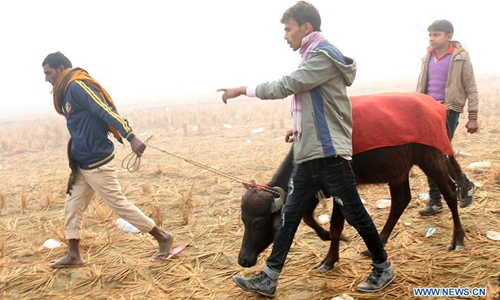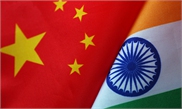SOURCE / INDUSTRIES
China bans imports of Indian cattle, products
South Asian country urged to promote product quality for exports: experts

People bring a buffalo to the sacrificial ceremony of Gadhimai festival near a temple in Bariyapur, Bara, Nepal, Dec. 3, 2019. Hindu devotees celebrate the Gadhimai festival, which takes place once in every five years, with the blood of freshly slain animals as the ritual sacrifice to Gadhimai, the goddess of power. (Photo by Sunil Sharma/Xinhua)
Following China's ban of both direct and indirect imports of cattle and relevant products from India due to the country's outbreak of infectious lumpy skin disease, Chinese experts urged India to improve the quality of its export products to reduce its trade deficit with China.
If the Chinese border inspection or any other agency finds illegally imported Indian cattle or relevant products, they will destroy the products, read an announcement on the website of the General Administration of Customs on Wednesday.
The new rule will likely deal a blow to India's beef exports.
Although China has banned direct purchases of buffalo meat from India since 2001 following an outbreak of foot-and-mouth disease in the South Asian country, India still sells buffalo meat to China via some Southeast Asian countries, said Yang Chun, a research fellow with the Chinese Academy of Agricultural Sciences.
India's shipments of buffalo meat and offal to the Chinese mainland via Vietnam, Myanmar, Thailand and the Hong Kong Special Administrative Region, slumped 23 percent year-on-year to 14,645 containers in the first 10 months of 2019, Indian news site The Economic Times reported, citing data from the All India Meat and Livestock Exporters Association.
"However, if India can improve the quality of its beef exports, it's possible for India to directly sell beef to China in the future along with growing market demand," Yang told the Global Times on Wednesday.
China's beef demand is between 7 million to 8 million tons a year, with the amount of imported beef expected to reach 1.5 million tons this year, up 50 percent year-on-year, she said.
However, India has repeatedly complained about its trade imbalance with China.
To narrow the imbalance, India should think about how to improve the competitiveness of its industries, companies and products, Dai Yonghong, a professor of the Institute of South Asia Studies at Sichuan University, told the Global Times.
"If India can produce high-quality products at good prices, why wouldn't Chinese like them? Why wouldn't Indian exports increase?" he asked.
Bilateral trade between China and India was on the rise in 2018. China exported $76.71 billion worth of goods to India, up 12.7 percent year-on-year, while imports from India stood at $18.83 billion, up 15.2 percent year-on-year, data from the Chinese Ministry of Commerce showed.
With a total population of about 2.7 billion, the two rapidly growing Asian countries have great potential in trade and economic cooperation, Dai said, noting that "India shouldn't rely solely on China to solve the trade imbalance problem; rather it should step up efforts to reform its own industries."

